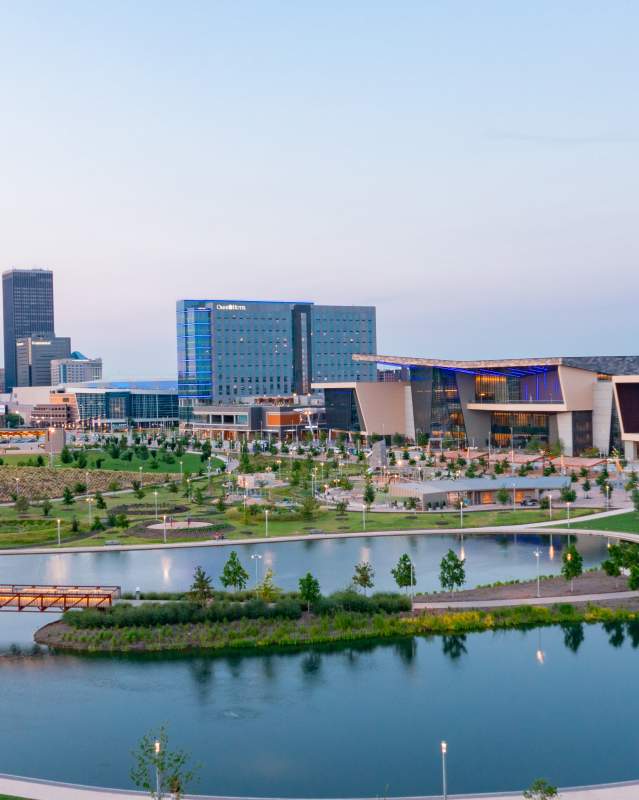With work nearing an end on the Chesapeake Finish Line Tower, promoters of the Oklahoma River envision a time not too far away when the waterway will be one of the city's top attractions.
The river is already winning accolades nationwide with water sports enthusiasts drawn to its shores - thanks to the Chesapeake Boathouse and Devon Energy Boathouses. Rowing regattas bring thousands to the once-maligned waterway.
But architect Rand Elliott and Oklahoma City rowing pioneer Mike Knopp see more acclaim ahead as construction wraps up on construction of the new Interstate 40 and the city completes a connection between the river and the nearby Bricktown Canal.
Knopp, director of the Oklahoma City Boathouse Foundation, sees the Finish-Line tower as key to attracting tourists and locals who may have never stepped foot in a boat.
Rising four stories into the air, the tower provides the only view of the downtown skyline, the river and the nearby American Indian Cultural Center. The tower also will act as a landmark for travelers on the new highway when it opens in 2012.
"It's going to be an iconic landmark along the river that will be a visitor center for people coming to the boathouse district, learning how they can be involved in activities down here," Knopp said. "We will have an observation deck on top where people will have an incredible view of the river."
The $6 million tower is set to open later this year; it is being paid for by Chesapeake Energy Corp. and will be given to the city (the foundation, tasked with overseeing development of boathouse row, also will operate the tower).
Sandwiched between the recently completed Devon Boathouse, the LED-lit Lincoln Boulevard bridge and the Chesapeake Boathouse, the Finish Line Tower rises 70 feet into the air. Though construction continues, a recent tour reveals much of the building and some of the amenities already in place.
The tower features an open area at the base that includes terrace seating for more than 100 people with an open fire pit (Knopp notes that in light of the tower's namesake, the flames will be fueled by natural gas).
"Whether people use the river for running, cycling or kayaking, those folks will have an opportunity to hang out here," Knopp said.
Knopp notes that the structural supports for the building are built to withstand the city's extreme weather conditions.
"This is probably the place you would want to be in case of a tornado, it's so reinforced," Knopp said.
An elevator and stairway will allow visitors to go up into the enclosed floors above, with increasingly impressive views the higher one goes. Space is dedicated for judges to get an up-close view of race finishes, while other space is set aside for media viewing areas and a viewing area for the public on the top floor.
Part of a larger whole
Elliott, who designed the Devon Boathouse and the Chesapeake Boathouse, drew up plans for the tower as part of a master plan that will also include at least two more boathouses that will be built by the University of Central Oklahoma and the University of Oklahoma.
"The notion of this being a rowing Mecca is at Mike Knopp's direction," said Elliott, who designed the Chesapeake Boathouse a decade ago after the namesake energy company turned what was going to be a humble log cabin into an award-winning architectural landmark. "Being around this sort of thing, Mike saw the potential. But at that time, I didn't imagine it would have international impact. But like all ideas, if it's given the chance to grow, then the potential grows. And that's what we have seen happen."
Elliott said boathouse row was a rare opportunity to take an area that had no real identity other than the river and create a virtual campus with the river running through it.
"The one thing that makes the boathouse development so strong and distinctive is there is a signature, and that's the compatible relationship between buildings," Elliott said.
"The arrangement of the boathouse district, along with the north shore of the Oklahoma River is very much a metaphor for the race itself," Elliott said. "Imagine the athletes in rowing shells at the starting line and racing forward. Imagine the boathouses at the edge of the river, and it's almost as if the edge is the starting line and the boathouses are symbols of the rowing shells themselves. ... it almost looks as if they are moving through the water and the finish line tower is what it's supposed to be - a marking of the end of the race."
Jun 2 Construction continues on the Chesapeake Finish Line...






